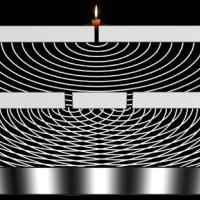
Physics in a minute: The double slit experiment
One of the most famous experiments in physics is the double slit experiment. It demonstrates, with unparalleled strangeness, that little particles of matter have something of a wave about them, and suggests that the very act of observing a particle has a dramatic effect on its behaviour.
To start off, imagine a wall with two slits in it. Imagine throwing tennis balls at the wall. Some will bounce off the wall, but some will travel through the slits. If there's another wall behind the first, the tennis balls that have travelled through the slits will hit it. If you mark all the spots where a ball has hit the second wall, what do you expect to see? That's right. Two strips of marks roughly the same shape as the slits.
In the image below, the first wall is shown from the top, and the second wall is shown from the front.
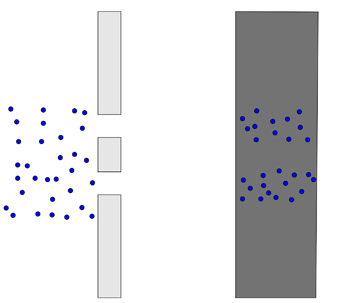
The pattern you get from particles.
Now imagine shining a light (of a single colour, that is, of a single wavelength) at a wall with two slits (where the distance between the slits is roughly the same as the light's wavelength). In the image below, we show the light wave and the wall from the top. The blue lines represent the peaks of the wave. As the wave passes though both slits, it essentially splits into two new waves, each spreading out from one of the slits. These two waves then interfere with each other. At some points, where a peak meets a trough, they will cancel each other out. And at others, where peak meets peak (that's where the blue curves cross in the diagram), they will reinforce each other. Places where the waves reinforce each other give the brightest light. When the light meets a second wall placed behind the first, you will see a stripy pattern, called an interference pattern. The bright stripes come from the waves reinforcing each other.
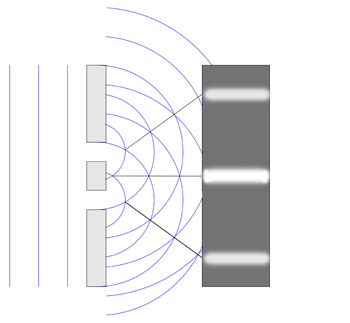
An interference pattern.
Here is a picture of a real interference pattern. There are more stripes because the picture captures more detail than our diagram. (For the sake of correctness, we should say that the image also shows a diffraction pattern, which you would get from a single slit, but we won't go into this here, and you don't need to think about it.)

Image: Jordgette, CC BY-SA 3.0.
Now let's go into the quantum realm. Imagine firing electrons at our wall with the two slits, but block one of those slits off for the moment. You'll find that some of the electrons will pass through the open slit and strike the second wall just as tennis balls would: the spots they arrive at form a strip roughly the same shape as the slit.
Now open the second slit. You'd expect two rectangular strips on the second wall, as with the tennis balls, but what you actually see is very different: the spots where electrons hit build up to replicate the interference pattern from a wave.
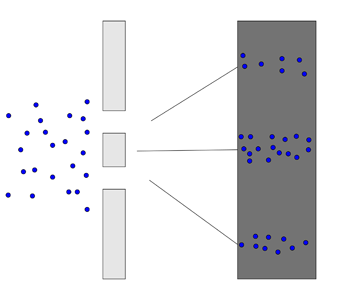
Here is an image of a real double slit experiment with electrons. The individual pictures show the pattern you get on the second wall as more and more electrons are fired. The result is a stripy interference pattern.
How can this be?
One possibility might be that the electrons somehow interfere with each other, so they don't arrive in the same places they would if they were alone. However, the interference pattern remains even when you fire the electrons one by one, so that they have no chance of interfering. Strangely, each individual electron contributes one dot to an overall pattern that looks like the interference pattern of a wave.
Could it be that each electrons somehow splits, passes through both slits at once, interferes with itself, and then recombines to meet the second screen as a single, localised particle?
To find out, you might place a detector by the slits, to see which slit an electron passes through. And that's the really weird bit. If you do that, then the pattern on the detector screen turns into the particle pattern of two strips, as seen in the first picture above! The interference pattern disappears. Somehow, the very act of looking makes sure that the electrons travel like well-behaved little tennis balls. It's as if they knew they were being spied on and decided not to be caught in the act of performing weird quantum shenanigans.
What does the experiment tell us? It suggests that what we call "particles", such as electrons, somehow combine characteristics of particles and characteristics of waves. That's the famous wave particle duality of quantum mechanics. It also suggests that the act of observing, of measuring, a quantum system has a profound effect on the system. The question of exactly how that happens constitutes the measurement problem of quantum mechanics.
Further reading
- For an extremely gentle introduction to some of the strange aspects of quantum mechanics, read Watch and learn.
- For a gentle introduction to quantum mechanics, read A ridiculously short introduction to some very basic quantum mechanics.
- For a more detailed, but still reasonably gentle, introduction to quantum mechanics, read Schrödinger's equation — what is it?
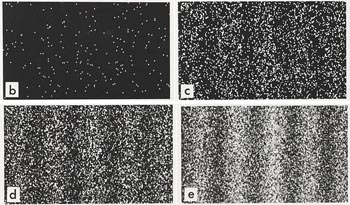
Comments
Chad Cathorall
The scientist at Washington University found that quasimeasurements cause the zeno effect possibly explaining why the particles do not form a interference pattern if one detects which slit they pass through.
Bill Mason
Seem to be leaving out the fact that the difference occurs when being actively observed.
Dominic Gannon
Everything we see is our brain "interpreting" the photons of light reflected off a object. Just like our brains turns 30 FPS and up into a smooth video image. Any experiment that has the word "Observation" in it is flawed. A human used as test equipment for the observation part of a experiment can never be accurate.
Whatever
It has nothing to do with a human observing anything. It has to do with how one observes things at the atomic and quantum scale. We make these observations by bouncing other particles off of the particles we're interested in examining. At the macro-scale this is not a problem as the particles were bounce off of things are much smaller and have little no affects at the macro.
But at the atomic and smaller scales, the particles we bounce off of things to observe them are similar in "size" (this is a stand in for mass, charge, etc.) to the particles we are trying to observe.
You can think of it like trying to figure out where a billiard ball is by bouncing a golf ball it. That will change the position, spin, etc. of the billiard ball.
DanLee
I agree with you. Yet, seemingly, the rest of the world either believes - when they do not believe what you've just said - humans have a psychic grip on subatomic particles, or this proves a God exists.
M. Allen
I believe both, and agree with both of you. The two dont have to be mutually exclusive... It actually makes for a more narrow view that way.
WILLIAM HOLLEY
I agree. What we don't know is much greater than what we do and much of what we think we know will change. I think it's best to leave room for many possibilities. Magic is just science undiscovered. If we keep placing boundaries on what's possible and teach others to ignore something for lack of explanations, scientific discovery suffers.
James Tedesco
The duality of the particle has nothing to do with proving a god exists, just that science is indeterminate and is a duality of possible existences dependent on the observation of a consciousness. Seems like its human consciousness that determines the outcome not any god.
Jeff
This isn't actually true either. Experiments have shown that even if the photon used to make an observation is of low enough energy that it doesn't alter a large molecules trajectory much, the interference pattern still disappears.
Also, null interaction experiments have been done in which there is no contact between particles at all. But if info about which slit can be found, the interference pattern disappears.
LaughingProphet
Hey, do you have a source on finding information about which slit with out active observation causing the interference pattern to not appear?
John E. Diller
Try QED: The Strange Theory of Light and Matter by Richard P. Feynman. It's been a while since I've enjoyed this book, but my recollection is that it covered the topic well.
Tallon
Thank you! I didn’t think that explanation made sense, since any effect upon the particle being observed would surely be taken into account in these experiments…and because the detection unit (which “catches” the electrons passing through either slit) doesn’t work by shooting particles at them, as far as I know…even if it did, that wouldn’t be ignored as a variable or whatever…right? I assume such interaction isn’t the method of detection anyway; how the materials used in the experiment could potentially influence the subject being measured is exactly what they control for, among other things- the environment itself, the actions taken as it is conducted and how conditions change…etc.
I just don’t think what the commenter described is true since, well, I’d assume the researchers would know that sort of thing could skew the results & therefore lead to an incorrect conclusion. Scientists aren’t just straight up missing the impact of what would be such an obvious flaw in these experiments. I mean, in general they either eliminate the possibility of their tools affecting what they’re measuring OR they take that into account as a variable. Usually the second one is only possible if it’s something that like…as long as it’s known, it won’t render their data useless…if that makes sense (so being aware that it is a factor is key) Anyway…
Suzanne
Molecules are much larger than photons, yet you get the same result.
Thomas M Koller
If a player has two attached low emission lasers either side of head, beamed through a double slit screen at, say, a home movie or scenario created by the player, bounces back as photons via player's retina to the player's neurons, will player perceive or believe he/she is part of the home movie?
Joe010204
Placing only 1 detector in front of one of the double slits ALSO collapses the wave function of both slits. This unequivocally proves that it isn’t the measurement method, but the ACT of measurement itself.
For example, we get the wave pattern. We place a detector in front of both holes we then get 2 bands. ..now, if it were the detector interfering as you mentioned, we will take 1 detector away and leave the other. This way only 1 slit has a detector that interacts with the electron as it passes through.
This would mean the slit with the detector produces a band while the slit without the detector produces a partial striped pattern of the wave.
This is not what we observe however. Measuring just 1 slit still causes 2 bands.
This is because even measuring just 1 slit gives us information on the other. It’s the information that is seemingly the cause of the collapse of the wave function.
Chris
Hello, I like your idea of removing one detector to see if there is a tangible difference. Given how complex the science behind this is, it doesn't seem ethical to have a biased conclusion with such conviction after just 1 adjustment.
Why has no one tried 3,4,5 slits? With those slits, why haven't we tried removing one detector at a time, and swapping out different ones for each slit? Speeding up or slowing down the particle beam? There are so many variables that could lead to comprehensible evidence if the results are as consistent to previous attempts.
However, it just seems this experiment was done 60 years ago and then we just left it as is with no additional input or further experimentation; just copy paste imitations doing the same thing for educational purposes of the original experiment. That just becomes a history lesson, not a science one.
I come here after watching a conspiracy theory and they referenced this experiment as the leading evidence that we live in a simulation, that the universe is just a projection controlled by a program that detects when its being observed like when a video game detects the players position and renders in whats necessary around them. Suggesting that the light particles can bend the rules of physics and time as soon as someone attempts to measure them.
My initial reaction is not to believe this, however I fully appreciate a rebuttal to come armed with objective, comprehensible evidence like any good debate where possible.
I think this experiment needs a make over and we need to breathe new life into it with far more variables to play with, leaving no stone unturned to draw a general trend and any potential outliers to help solve this once and for all. Or at least, as close as our minds will allow us.
We are our own limitations.
Benzeta
I agree with you, the whole furore around this experiment has made it more of a history lesson. It's become almost like the Galileo stone/feather thing; i've had people tell me that in normal every-day circumstances, if i dropped a pen and a pebble at exactly the same moment, they would hit the floor at the same time. Even, when i demonstrate this live, people are still adamant in their stance; after-all, i'm no better than Galileo.
This represents a great discrepancy to the original format of experiment by Galileo. I think some of these experiments have been so popularised in pop-culture and pop-science that people have ruled out the possibility of questioning them. Just like the Galileo stone and feather thing, Everyone is still quoting the same concept from decades ago without any iota of desire to question it. This means that some of these science-cum-history concepts are left to grow into "unquestionables" filled with errors.
I think its about time we re-visit the whole premise of this experiment. Let's introduce 3,4, or even 10 slits! Let's do it today with more control over the variables. We can't let this become another one of the "unquestionables". We can't adopt beliefs and never question them. That would be disastrously dogmatic. The opposite of what it means to do real science!
Also, what was the youtube video you watched? thanks
Betsy Johnson
Uh...no. That is definitely not what happens. If so, there would be no conceptual problem. But don't take my word for it. Here's what Richard Feynman said: “I think I can safely say that nobody really understands quantum mechanics." That's because QM seems to suggest that there's a real connection between the mind of the observer and the results obtained. Also, you're not taking into account the results of the quantum eraser phenomenon, which is another aspect of this experiment that suggests the trajectory of an electron in the past can be altered by an experimenter's actions in the present. You'll have to look it up as it's rather lengthy.
Sherry L Sass
Thank you so much for this explanation! We have been fretting about this for quite a while. I wish this physical interaction were more clearly included in other explanations of the slit experiment or just quantum mechanics and general
Tallon
You’re saying to observe a particle we’re bouncing particles off of that observed particle? I don’t think that’s the case. What exactly is bouncing off the particle being observed? How is it being directed toward the target particle? With the way they design these experiments, as far as I know, there should be no overt effect like that- certainly not the actual impact of matter as you’re describing. I don’t think anything is being expelled from the detection materials. Or if it were, that would be taken into account- so precise calculations would be made about how it should impact the results.
Basically, if something physical was being intentionally shot at the particles and that somehow was the way we detected them, then the scientists performing the research would do that math using specific measurements (including the mass of that projectile matter). I mean if there was anything being directed toward the electrons or whatever, they’d surely have an idea of what forces it would exert and the interaction it should have, etc…
Now you could say the electron being observed has some effect upon the detection unit itself (the “quantum observer”) because logically, in order to even register the electron’s presence/position, it must. But I believe that by all known science, there shouldn’t be any effect upon the particle being observed- other than the fact that it’s being observed. That’s kind of the whole point and is exactly what makes this discovery so mind-blowing…right? So I would assume that in these experiments, they’re controlling for those conditions (the observation device having any physical effect or exerting force upon the observed electron, and all possible variables). Do you disagree? I am genuinely curious about what you’re asserting!
g77enn
What if there are smaller units than photons, which are presently invisible to our instruments? We'll call them units of consciousness (or thought) that we as conscious beings emanate without knowing it, and it is these very tiny units of consciousness (relative to the photon) that influence the photons to behave as they do. In other words the invisible is influencing the visible like the soul influences the body. These same units could explain the placebo effect.
Pamela Talbot
I agree to your theory. Just want to point it out there as a suggestion to proof read your work before submitting it. I have I found a couple of mistakes where a word had been left out.
Retep Eloop
I thought it was well thought out and written. Has it been edited since your comment? If we're being semantic you may wish to check your spelling of courtesy.
Lauras
Objective observation, unlike subjective observation, is very much allowed in conducting data in experiments.
Plus, unless you have robots conducting the experiment ans/or collecting the data, humans are going to be involved.
Suzanne
A houseplant would work too. Humans cannot see at this level in any case. Machinery is used, and humans don't have to be in the room for the effects to continue. Observation just means measurement, and Wheeler's Delayed Choice and the Quantum Eraser experiments showed the measurement can occur after the photon, electron, or molecule has hit the wall...and it will still change.
John Clark
This word is used for convenience, but no conscious observer is required. You can also say “detected”. And by detected what is meant is that information exists that is, in principal, detectable even if not yet technically feasible. Look up “The World’s Smallest Double-Slit Experiment” (2007) and you will find that a single low-energy electron can be an “observer” and collapse the quantum interference pattern of a high-energy electron exiting a single hydrogen molecule.
Bleh
This is BS. When being observed by a sensor, electrons behave as particles. You lack sufficient understanding of the double slit experiment.
Blah
A summarily dismissal of a complex phenomenon that has world class physicists, accompanied by a " You don't understand" line illustrates a simple mind
john wick
wrong
Jonathan
Everything we recieve through our sences gets interpreted in our brains as being solid, founded by rules/laws/logic & most importantly being OUTSIDE our bodies, ie, being real. Reality is though, that these words you now read, are IN your head as is ALL experiences. Point being, WHY are we being TRICKED to think we are experiencing life OUTSIDE our heads when in fact, we are experiencing life IN our heads, just a observation.
Rev. Byrdman
The only reason a human may not be good test equipment for observation would be because the person lacks awareness. Human observation can be as accurate as any mechanical scientific devise. It just depends on the awareness of the individual.
secphy
by detector , they mean, not human but mechanical
amy shmayme
"Seem to be leaving out the fact that the difference occurs when being actively observed" EXACTLY!! This experiment shows that matter is not what we think it is. Scientists have known this for a century yet scientific materialism for some reason still prevails. Matter is a product of Mind. NOT the other way around. For more information read "Ontological Mathematics"
Brandon
That is not what comes out this. "Observer" is a misleading term. It does not specifically refer to humans, nor even conscious creatures, although they can be.
Albert Einstein
I do agree with you
JM Urso
Ive noticed this trend everywhere. I chock it up to the materialists clinging to their dead ideology
George G
What happens as the distance between the slits becomes greater ?
Is there a relationship between the distance between the slits, and the distance of the source from the slits??
Chris Isaacson
What if the light is reacting to the material the slits were cut out from. Maybe electromagnetism causing the light particles to bend and change their direction just like how planets and comets change their orbits when passing near something with mass.
Monis Alam
The double slits, are on the both sides of the direction of the flow of light. Also, the slit will be more massive on the two outer edges of the double slits. If it were to be hindered due to presence of slits, wouldn't the effect be more on the outer edges and not on the inner edges, i.e. in the middle.
VonVerschwitz
Such is the problem. Particles don't bend when acted upon by electromagnetic fields. They simply form a trajectory. Bending or warping is the property of a wave. Their trajectory could be altered but I'm sure the material is neutral in all aspects to avoid interference.
John Park
Electrons have almost no mass and therefore almost no gravity. Atoms of the slit have a huge mass compared to the electrons. As the electrons passes the slit the gravity of the atoms cause some of the closest electrons to start to spin, the same way water spins when shot through a slit. This spin then sends some of the electrons out of their normal straight line trajectory which causes the apparent wave effect.
Louis
If that were the case it would happen if there was only one slit. But it doesn't.
DARYL MESSENGER
Jeff
Electrons always have a spin of 1/2. This is a fundemental property of electrons and all fermions.
Even if electrons were pushed off their trajectory, how do electrons shot one at a time form an interference pattern?
Bc Magician
Because it behaves like wave regardless by itself or by groups
No-all
When you say wave, do you mean as in bye bye?
Daniel
If light passes through two slits and it reflects off a object that photon leaves some of itself behind and continues on as if you put paint on your hand and slap a wall then run, how many walls you slap depends on how much paint you got, when light reflects off the object or the slit where does it go is it passing through itself or is it colliding with itself in that direction and handing itself some extra light to continue like say you been running with paint on your hand and you have a train of people that follow you and you are the leader. What if you grab just a finger swap of paint for that extra inch foot mile etc. so when the rays reflects off the rectangle will that rectangle of photons continue colliding into each other and handing itself more photons or snatching some to create a another rectangle and so on till it fades away.
Miklos Legrady, Toronto editor for Chicago's New Art Examine
I also thought the materials used may have properties that interfere, and the detector might too.
Richard Ocaya
How does the detector itself work? Does it not rely on an intrinsic property of electrons to function? Connecting the detector to that property then necessarily interferes with the experiment. That interference is then to be expected and can be explained rationally rather than through a spooky effect, quantum effect.
Alok Verma
Agree with you. Details of double/single slit experiments should give more information on the slits material, their dimensions (gap width and distance between slits) and the probability of these materials influencing the path/direction of WAVICLES (waves-cum-particles!). This topic needs to discussed and debated.